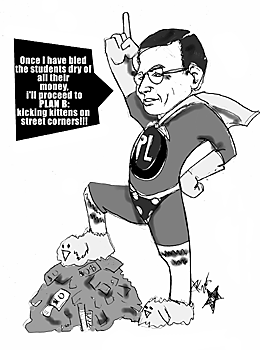
Illustration by Holly Randall
|
|
By Keren G. Raz
Arizona Daily Wildcat
Monday, February 28, 2005
Print this
Some might call President Peter Likins the enemy of undergraduate education. Some students even say he's more alumni friendly than student friendly.
After all, from his office on the seventh floor of the administration building, students say, he can see the Alumni Plaza, but can he really be aware of what matters to students? Or just look at his past track record.
Over the past two years, it seems that the most significant changes and financial decisions at the UA focus solely on business and scientific research, not undergraduate education. Last week administrators announced a tuition hike and a slew of program fees for architecture, technology, business and engineering. For the past two years attention has focused on securing money for science buildings and funding for the improvement of science programs, including the new buildings for the biotechnology buildings in the Arizona Health Sciences Center. And on top of all this, proposals are sitting before the legislature right now asking for money for hydrology and health sciences.
An examination of this track record would help anyone understand why critics of administration constantly ask the question: when do we start improving undergraduate education?
But when Likins' track record is looked at closely, it becomes apparent that the perception of Likins as the enemy of the students and the enemy of the undergraduate education is a myth.
The criticism of Likins misses the bigger picture, the bigger picture that administrators can never forget. The university financial situation is abysmal right now. Administrators are looking at the possibility of another $4 million shortfall next year if they have to absorb legislative cuts to the retirement fund.
In a meeting with the Arizona Daily Wildcat last week, Likins explained his approach to financing the university. It's a matter of investments, he said.
While student leaders want any tuition proposal to commit money to class availability, the top concern voiced by students in a campus-wide survey, Likins is looking elsewhere to improve undergraduate education. He's looking to change the dynamics of the freshman class.
Next year the UA will become more selective in admitting its freshmen class. It will no longer have to admit the top 50 percent of each freshmen class, it only has to accept the top 25 percent. Anyone below the top 25 percent will now have to submit essays and undergo a more individualized selection process that administrators are still hammering out with software.
This, Likins said, is our investment in the future of the UA. When it comes to undergraduate education, administrators are investing not only in putting money towards classes (Likins' draft budget includes more than $30 a head for class availability) but also in improving the freshmen class.
On first glance, that's an outrage. That means more money than ever before is going to recruitment of National Merit Scholars and top students in-state and out-of-state. More money is also going to freshmen retention. And 29 percent of tuition is put toward need based aid and merit aid.
Unfortunately, as outrageous as it is, it's crucial at this stage for the UA.
While last year's freshmen retention rate seems high at 80 percent, the overall graduation rate is very low at about 57 percent. That means that money student leaders want put towards class availability will also be spread out over about half of the student population, who will not even graduate. As Likins puts it, it's better to recruit and select students who will succeed so every dollar is well spent rather than continue putting money toward those who would benefit from an education at a less demanding institution.
So those freshmen who are alarmed by the rising cost of tuition, rest assured that you will see improvements in your education someday, especially if you keep up the call for a better undergraduate education.
If students can keep up the pressure they are putting on administrators to improve class availability, they soon will. Alistair Chapman, Associated Students of the University of Arizona student body president, has brought class availability to the table, and if the next set of student leaders push it, they will eventually prevail.
The student voice is a powerful one. To understand that, just look at the new student section in McKale Center. The students wanted it, lobbied for it for years, and now they have it.
Likins does listen to students and he's trying to keep the UA's long-term interests in mind. He's not the enemy of students. He's just facing financial reality.
Unfortunately for seniors, we'll never get to see the changes we want, but at least we can take comfort in the fact that we haven't had to pay that much for it.
Keren Raz is a senior majoring in English and political science. She can be reached at letters@wildcat.arizona.edu.
